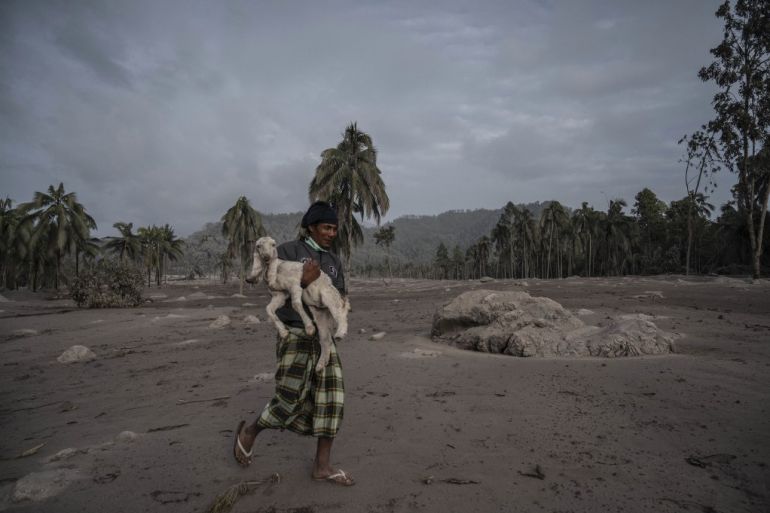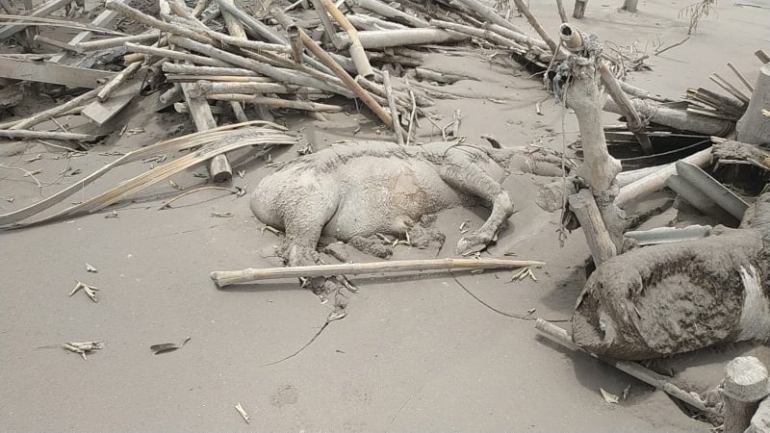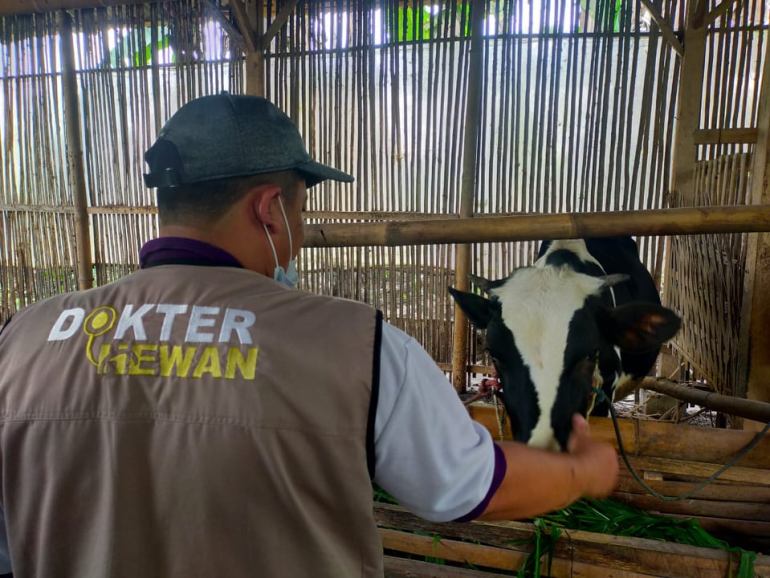Rush to save animals in Indonesia after deadly Mt Semeru eruption
Veterinarians work from sunrise to sunset to evacuate and treat animals suffering from burns, smoke inhalation and other injuries.

Surabaya, Indonesia – Dr Sugeng Widodo has just finished his latest shift working in the shadow of Indonesia’s fearsome Mount Semeru – an active volcano on the island of Java that erupted on Saturday night following heavy rains that collapsed its crater.
Since the eruption, which spewed an ash cloud 4km (2.48 miles) into the air and prompted deadly volcanic mudflows, the veterinarian has been volunteering at the site of the disaster, which killed more than 30 people and left dozens missing and at least 3,000 others displaced.
Keep reading
list of 4 itemsDeath toll from Indonesia volcano eruption rises to 14
‘All of a sudden, the sky turned dark as rains, hot smoke came’
In Pictures: Indonesia volcano eruption death toll rises
Widodo is the coordinator of the East Java II volunteer team of the Indonesian Veterinary Medical Association (IVMA) and has been working to help and rescue some of the often forgotten victims of the volcanic eruption: the area’s animals and livestock.
Along with his small team of three to four other volunteers, the veterinarians work from sunrise to sunset along with veterinary paramedics to evacuate and treat animals suffering from burns, smoke inhalation and other injuries.
“Today I was in Supiturang village. We have evacuated 150 cows and 200 sheep,” he told Al Jazeera.
“We have found 17 dead cows and 50 dead sheep so far. Some animals that were injured and couldn’t be saved were immediately sold by their owners.”
The area around the volcano is known for two things: its sand mining industry and its farming. Verdant lands surround the mountain and the fertile volcanic soil it produces, and the greenery, make it an ideal spot to graze cattle, goats and sheep.
‘This will be the day I die’
Marzuki Suganda, a 30-year-old truck driver at a local sand mine, told Al Jazeera that he knew almost all of the dead and missing, many of whom were farmers who were on the slopes of the mountain and were either unable or unwilling to leave their animals and flee in time.
Suganda, who had been on his way home from work at the sand mine on the day of the eruption, said that the sky turned dark before volcanic rocks flew through the air, striking his head and back, and causing him to fall to the ground.
“I thought, ‘This will be the day I die’. I was ready. I thought, ‘It’s OK. I was born here in Curuk Kobokan village and I’ll die here too,'” he said.
“Life and death flashed before my eyes.”
As he looked around for a place to shelter, Suganda said that there was simply nowhere to go as homes were destroyed by the falling debris, leaving him to crouch at the side of the road and cover his head with his motorbike helmet and hands. Animals grazing by the roadside were buried in the thick ash that descended on the villages around Semeru.

The eruption also destroyed Suganda’s home. The tiles crumbled under the weight and heat of the volcanic ash, and the roof of his house has been replaced by a giant hole.
“My house is no longer liveable. It has traumatised me,” he said.
Suganda, his wife and five-year-old daughter are now sheltering in a nearby village with other residents from the district while they wait to be permanently evacuated and resettled elsewhere. There are 11 goats also staying with the displaced villagers, who had tried in vain to save their livestock when the eruption started.
‘Everything is covered in ash’
Some of the villagers sheltering with him have sold any cattle they were able to save as they can no longer take care of them.
Suganda and Widodo said that there has been something of a buying frenzy as villagers in neighbouring areas unaffected by the eruption and livestock traders have bought up excess animals.
According to vet Widodo, the biggest challenge now is finding enough fresh greenery for the animals that survived the disaster.
“Everything is now covered in ash,” he said. “If the animals eat that, they will get respiratory infections and start to cough.”
Widodo said that he and his colleagues are now working to prepare stocks of fresh grass, supplements and medicine for the injured and evacuated animals.

While supplies are plentiful, in part due to a fundraising drive launched online by the IVMA group, getting food and medicine to the right locations is challenging, as is storing grass and other vegetation so that it does not rot before it can be eaten.
“The affected area is not safe because Mount Semeru is still active, so access to affected locations is limited,” Abdul Muhari, the head of the Disaster Information and Communication Data Center at the National Agency for Disaster Management (BNPB), told Al Jazeera.
“We are still in the process of trying to evacuate all surviving livestock.”
On Monday, Semeru erupted again, spewing smoke and ash into the sky and hampering rescue efforts.
Still rumbling
Semeru is one of at least 100 active volcanoes in Indonesia, which is located on the Pacific “Ring of Fire” – a confluence of tectonic plates that create frequent seismic activity.
In addition to caring for surviving livestock, Widodo said that there are other concerns regarding how to deal with the dead so as not to spread disease in the aftermath of the eruption, as the animals will start to decompose relatively quickly.
“Currently one of the most urgent things we need to do is clear and count the dead animals that have started to rot,” Widodo said, adding that logistics were again difficult due to the remote locations involved.
“These animals are close to the peak of Semeru and many were in homes or cages which collapsed because of the eruption,” he said.
A few days after the eruption, Suganda ventured back to his home to see if he could find and save some of his belongings like documents and jewellery.
He could barely open the door of his home because of volcanic mud about 40cm (16 inches) deep in places.
“Thank God, I was able to find a few important papers like school diplomas and the certificate for the house. I was able to save them even though they were covered in mud. I’ve already come to terms with the state of the house. What else can I do, it’s been destroyed,” he said.
As he looked around his mud-cloaked village, Suganda noted the eerie quiet that has descended on the usually bustling community.
“The only things still alive are chickens and cats,” he said.